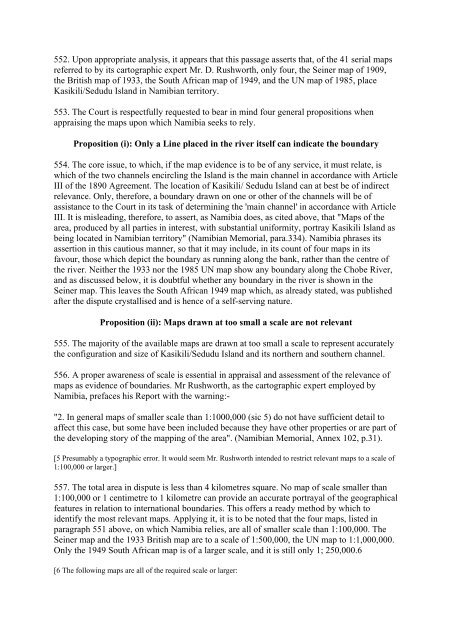botswana/namibia - Cour international de Justice
botswana/namibia - Cour international de Justice
botswana/namibia - Cour international de Justice
Create successful ePaper yourself
Turn your PDF publications into a flip-book with our unique Google optimized e-Paper software.
552. Upon appropriate analysis, it appears that this passage asserts that, of the 41 serial maps<br />
referred to by its cartographic expert Mr. D. Rushworth, only four, the Seiner map of 1909,<br />
the British map of 1933, the South African map of 1949, and the UN map of 1985, place<br />
Kasikili/Sedudu Island in Namibian territory.<br />
553. The <strong>Cour</strong>t is respectfully requested to bear in mind four general propositions when<br />
appraising the maps upon which Namibia seeks to rely.<br />
Proposition (i): Only a Line placed in the river itself can indicate the boundary<br />
554. The core issue, to which, if the map evi<strong>de</strong>nce is to be of any service, it must relate, is<br />
which of the two channels encircling the Island is the main channel in accordance with Article<br />
III of the 1890 Agreement. The location of Kasikili/ Sedudu Island can at best be of indirect<br />
relevance. Only, therefore, a boundary drawn on one or other of the channels will be of<br />
assistance to the <strong>Cour</strong>t in its task of <strong>de</strong>termining the 'main channel' in accordance with Article<br />
III. It is misleading, therefore, to assert, as Namibia does, as cited above, that "Maps of the<br />
area, produced by all parties in interest, with substantial uniformity, portray Kasikili Island as<br />
being located in Namibian territory" (Namibian Memorial, para.334). Namibia phrases its<br />
assertion in this cautious manner, so that it may inclu<strong>de</strong>, in its count of four maps in its<br />
favour, those which <strong>de</strong>pict the boundary as running along the bank, rather than the centre of<br />
the river. Neither the 1933 nor the 1985 UN map show any boundary along the Chobe River,<br />
and as discussed below, it is doubtful whether any boundary in the river is shown in the<br />
Seiner map. This leaves the South African 1949 map which, as already stated, was published<br />
after the dispute crystallised and is hence of a self-serving nature.<br />
Proposition (ii): Maps drawn at too small a scale are not relevant<br />
555. The majority of the available maps are drawn at too small a scale to represent accurately<br />
the configuration and size of Kasikili/Sedudu Island and its northern and southern channel.<br />
556. A proper awareness of scale is essential in appraisal and assessment of the relevance of<br />
maps as evi<strong>de</strong>nce of boundaries. Mr Rushworth, as the cartographic expert employed by<br />
Namibia, prefaces his Report with the warning:-<br />
"2. In general maps of smaller scale than 1:1000,000 (sic 5) do not have sufficient <strong>de</strong>tail to<br />
affect this case, but some have been inclu<strong>de</strong>d because they have other properties or are part of<br />
the <strong>de</strong>veloping story of the mapping of the area". (Namibian Memorial, Annex 102, p.31).<br />
[5 Presumably a typographic error. It would seem Mr. Rushworth inten<strong>de</strong>d to restrict relevant maps to a scale of<br />
1:100,000 or larger.]<br />
557. The total area in dispute is less than 4 kilometres square. No map of scale smaller than<br />
1:100,000 or 1 centimetre to 1 kilometre can provi<strong>de</strong> an accurate portrayal of the geographical<br />
features in relation to <strong>international</strong> boundaries. This offers a ready method by which to<br />
i<strong>de</strong>ntify the most relevant maps. Applying it, it is to be noted that the four maps, listed in<br />
paragraph 551 above, on which Namibia relies, are all of smaller scale than 1:100,000. The<br />
Seiner map and the 1933 British map are to a scale of 1:500,000, the UN map to 1:1,000,000.<br />
Only the 1949 South African map is of a larger scale, and it is still only 1; 250,000.6<br />
[6 The following maps are all of the required scale or larger:

















